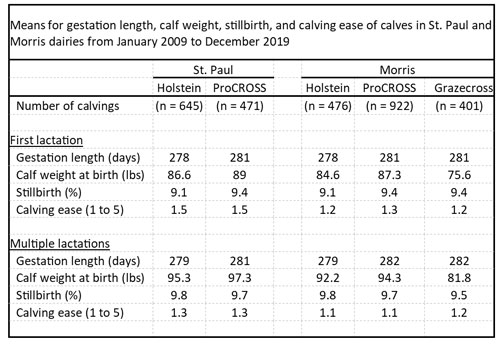By Glenda Pereira, PhD Animal Science student, and Brad Heins, WCROC Dairy Scientist
May 2020
Calving problems prolong the ability of dairy cows to reach peak production, and may impair the ability of a cow to calve again. First lactation cows that have a difficult birth, may have increased labor and veterinary costs. Furthermore, there is an increased probability the cow may not survive, which can cost $2,000 before the heifer may enter the milking herd. Moreover, calves that are born with difficulty are more likely to be stillborn or develop a digestive or respiratory disease.
While superb management may help minimize calving problems, recording calving traits may also be valuable. At the University of Minnesota dairy research herds, calving traits are recorded to improve cow and calf health. Gestation length is the date of successful insemination subtracted from the date of calving. Birth weight is measured within 12 hours of birth. Stillbirth is recorded as either living or dead within 24 hours of birth. Calving ease is measured on a 5-point scale, with: 1 = quick, easy birth with no assistance; 2 = over 2 h in labor, but no assistance; 3 = minimum assistance, but no calving difficulty; 4 = used obstetrical chains; and 5 = extremely difficult birth that required a mechanical puller. Stillbirth and calving ease scores may be entered in any dairy management software program for tracking of individual dairy herds.
The University of Minnesota has two research herds; a high-input dairy in St. Paul and a low-input pasture dairy in Morris. Cows in St. Paul calve from September to May and are bred from December to July. Cows in Morris calve seasonally and are bred to maintain a seasonal production system. The two herds have Holstein cows and ProCROSS crossbreds, composed of the Montbéliarde, Viking Red, and Holstein breeds. In the Morris dairy herd, Grazecross crossbreds are composed of the Normande, Jersey, and Viking Red breeds.
The accompanying table has means for calving traits from St. Paul and Morris, for first lactation cows and cows with multiple lactations from January 2009 to December 2019. In St. Paul, Holstein calves had a shorter gestation length than ProCROSS calves. Gestation length is influenced by the genetics of the calf, and a longer gestation length has been documented in the Montbéliarde breed. Holstein calves had mean weight that was 2 pounds less than ProCROSS calves. The longer gestation length reported for ProCROSS calves may explain the higher weight at birth. Stillbirth and calving ease were similar for Holstein calves compared with ProCROSS calves.
In Morris, Holstein calves had a shorter gestation length than ProCROSS and Grazecross calves. Calf birth weight was different between the breed groups in Morris, and Holstein and ProCROSS calves weighed more than Grazecross calves. This was anticipated because some Grazecross calves were sired by Jersey bulls, and Jerseys have lower body weight than other dairy breeds. Similar to St. Paul, stillbirth and calving ease were similar for Holstein calves compared with ProCROSS and Grazecross calves.
While similar breeds for crossbreeding exist in St. Paul and Morris, there are management differences that influence calf weight at birth. In Morris, cows that are dry during the summer months are on pasture, and have less energy intake compared with dry cows in St. Paul that are fed a TMR. Additionally, calving ease was slightly higher in St. Paul than in Morris and this may be due to a higher rate of unobserved calvings in Morris than in St. Paul.
Dairy producers should consider genetic evaluations for calving ease of potential service sires especially for mating virgin heifers. Using different sire breeds, might reduce costs associated with difficult births. Recording birth traits on farm can help producers improve cow and calf health and reduce financial loss.

